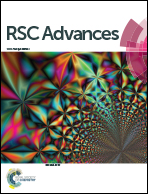Penicimutamides A–C: rare carbamate-containing alkaloids from a mutant of the marine-derived Penicillium purpurogenum G59†
Abstract
Three rare carbamate-containing alkaloids, penicimutamides A–C (1–3), were isolated from a fungal mutant from the diethyl sulfate (DES) mutagenesis of marine-derived Penicillium purpurogenum G59. Their structures, including their absolute configurations, were determined by spectroscopic methods, especially the X-ray crystallography and CD analyses. HPLC-UV and HPLC-MS analyses evidenced that 1–3 were only produced in the mutant strain via biosynthetic pathways that were silent in the parental strain and activated by DES mutagenesis.


 Please wait while we load your content...
Please wait while we load your content...